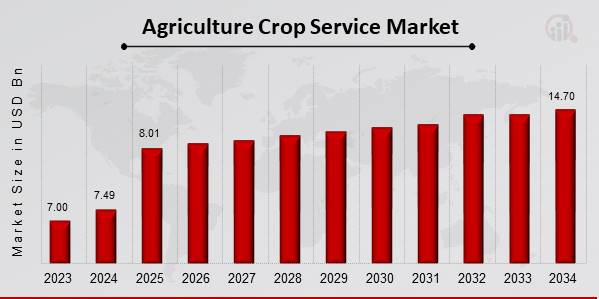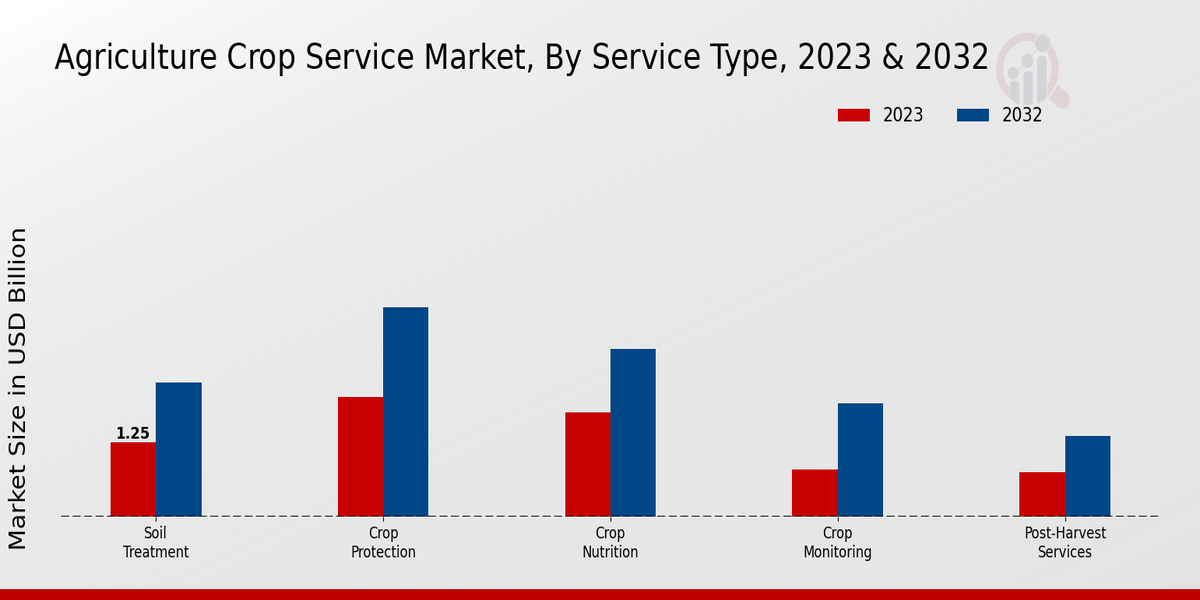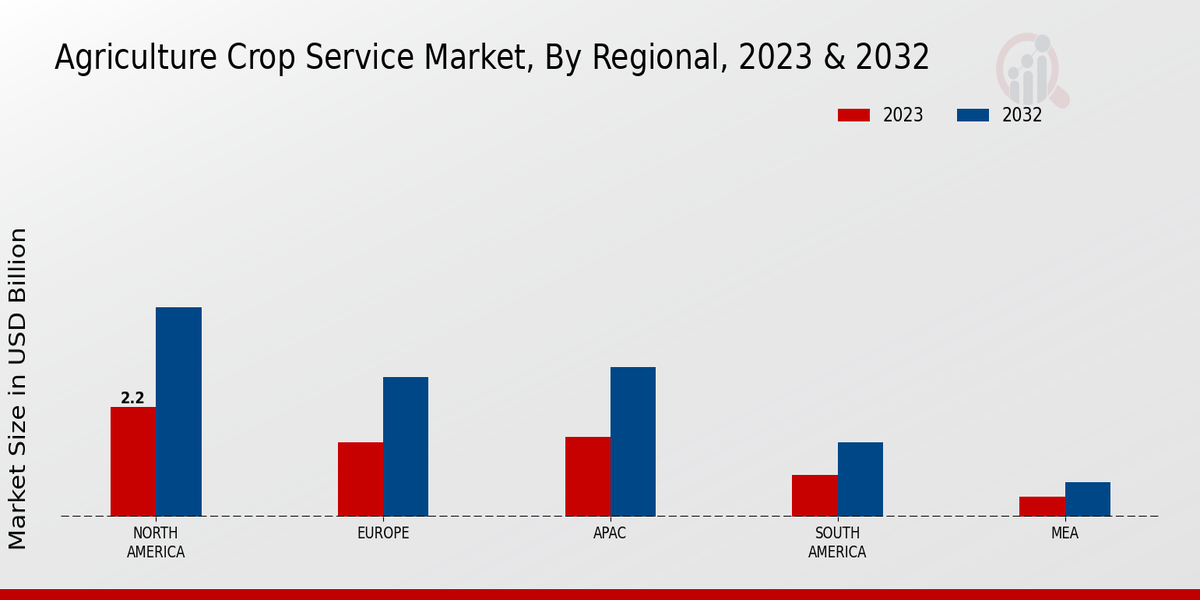Global Agriculture Crop Service Market Overview
Agriculture Crop Service Market Size was estimated at 7.49 (USD Billion) in 2024.The Agriculture Crop Service Industry is expected to grow from 8.01 (USD Billion) in 2025 to 14.70 (USD Billion) by 2034. The Agriculture Crop Service Market CAGR (growth rate) is expected to be around 7.0% during the forecast period (2025 - 2034).

Source: Primary Research, Secondary Research, MRFR Database and Analyst Review
Key Agriculture Crop Service Market Trends Highlighted
The market for such services is growing, especially for the Global Agriculture Crop Service Market where various leading market drivers such as population growth and increased demand for food, and the shifting towards ecofriendly farming techniques are leading the way. Such trends are dictating increasing adoption by farmers of new technologies including precision agriculture and data analytics for increased productivity and crop yields. This is coupled with government policies and measures encouraging agricultural development and promoting its green practices which also contribute positively to the growth of the market. Many prospects are yet to be explored in this market. With the concerns of the population on measures to conserve the environment, the focus has turned into organic agriculture and bio-based crops protection products.
Companies producing biofertilizers and biopesticides are in a good position to meet the growing green products market. In addition, the application of digital farming technologies provides an opportunity to enhance resources and supply chain management towards the benefit of the entire sector. Recent trends also suggest a wider acceptance of digital technologies such as mobile apps and the Internet of Things applications in the farming value chain. Big data analytics is set to influence farming activities since farmers are trying to achieve the highest possible returns while ensuring the least possible losses. In addition, a growing concern about climate change has stimulated the shift towards regenerative farming practices, which restore soil health and biodiversity.
This integrated system not only brings a positive impact on the environment but also increases crop resilience. In general, the trends in the market can be described as innovative and flexible as they respond to changing market needs and environmental factors with an aim of ensuring sustainable food production in the future.
Agriculture Crop Service Market Drivers
Increase in Global Food Demand
One of the most significant drivers of growth in the Global Agriculture Crop Service Market Industry is the relentless increase in global food demand. As the world population steadily increases, there is a corresponding surge in the need for efficient food production systems. By 2030, the global population is projected to reach approximately 8.5 billion, leading to an extraordinary demand for agricultural produce. This growing consumer base necessitates the use of advanced agricultural services to optimize crop yields, reduce waste, and ensure sustainability in farming practices.Furthermore, changing dietary preferences, particularly in developing countries, signal a shift towards more diverse and nutrient-rich food sources. As consumers seek higher quality and varied food products, the pressure on farmers to adopt innovative agricultural practices grows. In response to this demand, agricultural crop service providers are stepping up to offer solutions that enhance productivity through precision farming techniques, data analytics, and improved supply chain management.These advancements not only help in maximizing yields but also contribute to reducing the environmental impacts associated with agriculture, thereby aligning with the global shift towards sustainable practices. This trend is expected to strongly influence the Global Agriculture Crop Service Market, paving the way for future innovations designed to meet the evolving needs of the agricultural sector and promote food security.
Technological Advancements in Agriculture
Technological advancements play a pivotal role in driving the Global Agriculture Crop Service Market Industry forward. The integration of cutting-edge technologies such as precision agriculture, drones, IoT devices, and AI-driven analytics has revolutionized the way farmers monitor and manage their crops. These technologies enable farmers to collect real-time data on soil conditions, weather patterns, and crop health, allowing for more informed decision-making.As a result, farmers can implement tailored solutions to optimize their operations, improve yields, and reduce costs. The continuous evolution of agricultural technology opens new avenues for crop service providers to offer innovative services, further propelling market growth.
Government Initiatives and Support
Government initiatives and support for the agricultural sector are crucial drivers of growth in the Global Agriculture Crop Service Market Industry. Many governments worldwide are implementing policies to enhance agricultural productivity and sustainability. These initiatives often include financial incentives, subsidies, and grants for farmers who adopt advanced agricultural practices and technologies. By fostering an environment conducive to agricultural innovation, governments are encouraging farmers to invest in crop services that can improve their operations.This stems from a broader recognition of the importance of food security and sustainable farming practices as global priorities, making government support a key factor in the expansion of this market.
Agriculture Crop Service Market Segment Insights:
Agriculture Crop Service Market Service Type Insights
The Global Agriculture Crop Service Market is a dynamic segment expected to witness significant growth in the coming years. This market is segmented into various service types, each playing a vital role in increasing agricultural productivity and ensuring sustainable agricultural practices. In 2023, the Soil Treatment segment is valued at 1.25 USD Billion and is crucial for enhancing soil quality, directly impacting crop yields. By 2032, this segment is projected to grow to 2.25 USD Billion, highlighting its importance in improving soil health through various treatments and amendments, hence contributing significantly to the overall market.
The Crop Protection segment represents a major portion of the market, valued at 2.0 USD Billion in 2023 and expected to reach 3.5 USD Billion by 2032, making it one of the dominant service types. Protecting crops from pests, diseases, and weeds is critical for maintaining yield and quality, demonstrating the essential role this segment plays within the agricultural sector. Crop Nutrition is also significant with an initial valuation of 1.75 USD Billion in 2023 and an expected growth to 2.8 USD Billion in 2032, indicating the necessity of providing essential nutrients for plant growth which directly correlates with crop productivity.The Crop Monitoring segment, valued at 0.8 USD Billion in 2023, is projected to increase to 1.9 USD Billion, reflecting the growing use of technology in monitoring crop health and ensuring timely interventions. This service is increasingly important for optimizing agricultural practices through data analytics, enabling farmers to make better-informed decisions. Finally, Post-Harvest Services, valued at 0.75 USD Billion in 2023, aim to minimize losses after harvesting, projected to reach 1.35 USD Billion by 2032. This segment is crucial as it ensures the quality and quantity of produce, preventing loss throughout the supply chain.Overall, the diversity within the Global Agriculture Crop Service Market segmentation showcases various growth drivers and challenges peculiar to each service type, while also uncovering substantial opportunities for innovation and advancement within the agricultural industry. The increasing demand for sustainable farming practices, along with technological advancements in monitoring systems and nutrient delivery, positions these service types as essential components for boosting agricultural efficiency and resilience globally.

Source: Primary Research, Secondary Research, MRFR Database and Analyst Review
Agriculture Crop Service Market Crop Type Insights
The Global Agriculture Crop Service Market is projected to achieve a valuation of 6.55 billion USD in 2023, with a promising growth trajectory. The market is categorized into various crop types, including cereals, fruits, vegetables, pulses, and oilseeds, each contributing significantly to the overall market dynamics. Cereals comprise a major sector due to their wide-ranging applications in food and feed. Fruits and vegetables are also critical, driven by the rising health-conscious consumer trends, leading to an increasing demand for fresh produce.
Pulses are gaining traction as a sustainable source of protein, aligning with global dietary shifts towards plant-based food. Oilseeds dominate the market owing to their essential role in cooking oils, biodiesel, and animal feed, making them indispensable. The Global Agriculture Crop Service Market statistics reflect a diverse spectrum of opportunities as well as challenges, such as climate change and resource scarcity, influencing farming practices. With the expected growth in population, the demand for varied crop types is anticipated to bolster the market further, fostering innovation in agricultural practices and services.The growth drivers are complemented by the need for sustainable farming solutions, thus representing a vital area within the industry where advancements can create a lasting impact.
Agriculture Crop Service Market Application Method Insights
The Global Agriculture Crop Service Market is projected to be valued at 6.55 USD Billion in 2023, showing robust growth driven by the increasing demand for enhanced agricultural productivity. The Application Method segment plays a crucial role in this market, as it encompasses various techniques that are essential for effective crop management and yield optimization. Among these methods, Spraying is widely used for the distribution of pesticides and fertilizers, ensuring uniform application and minimizing waste. Soil Injection is another significant method, allowing for deeper penetration of nutrients directly into the root zone, which enhances absorption and reduces environmental runoff.
Fertigation, a combination of fertilization and irrigation, is increasingly popular as it efficiently delivers nutrients through irrigation systems, promoting better crop growth while conserving water. Seed Treatment is vital in protecting seeds from diseases and pests, significantly impacting germination rates and crop establishment. As a result, these methods are becoming more prominent in precision agriculture strategies, influencing the Global Agriculture Crop Service Market revenue through improved efficacy and sustainability in agricultural practices.
Agriculture Crop Service Market End Use Insights
The Global Agriculture Crop Service Market is projected to be valued at 6.55 USD Billion in 2023, reflecting a growing emphasis on crop services tailored for various end uses. The market is categorized as including key players like farmers, agricultural cooperatives, and food processing companies. Farmers play a crucial role, as they directly influence crop yield and quality through their adoption of specialized services. Agricultural cooperatives significantly contribute by pooling resources, thereby enhancing service accessibility and reducing costs for members.
Food processing companies also hold a vital position in this segment, requiring quality raw materials for production, which drives demand for effective crop services. Overall, the Global Agriculture Crop Service Market segmentation demonstrates how these end-use sectors interact, with each playing a pivotal role in the growth and sustainability of agricultural practices. As the market dynamics shift, the interplay between these sectors will continue to shape the Global Agriculture Crop Service Market revenue, presenting both challenges and opportunities for growth.
Agriculture Crop Service Market Regional Insights
The Global Agriculture Crop Service Market is set for notable growth across various regions, with a total expected market valuation of 6.55 USD Billion in 2023. North America holds a significant position, with a valuation of 2.2 USD Billion in 2023, which underscores its majority holding in the market due to advanced agricultural technology and strong investment in crop services. Europe follows with an estimated value of 1.5 USD Billion in 2023, benefitting from a robust regulatory framework that fosters innovation in farm services. The APAC region, valued at 1.6 USD Billion, is emerging rapidly, driven by increasing agricultural demand and rising investments in agri-tech solutions.
South America, while smaller at 0.85 USD Billion, is growing due to a rich agricultural base and investment in sustainable practices. Lastly, the Middle East and Africa (MEA) segment is valued at 0.4 USD Billion, reflecting challenges in agricultural productivity but also highlighting potential opportunities as investment in agricultural services increases. Together, these regions contribute to a diversified landscape within the Global Agriculture Crop Service Market, with varying dynamics that influence growth and development across the sector.

Source: Primary Research, Secondary Research, MRFR Database and Analyst Review
Agriculture Crop Service Market Key Players and Competitive Insights:
The Global Agriculture Crop Service Market is experiencing dynamic growth propelled by increasing agricultural demands and advancements in farming technologies. This market comprises a wide range of services that enhance crop productivity and sustainability, including soil management, pest control, crop protection, and precision farming solutions. Competitive insights in this sector reveal a landscape characterized by innovation, strategic partnerships, and a strong focus on sustainability. As the agricultural sector faces challenges such as climate change and population growth, companies are investing in research and development to introduce new technologies and improved services that address these issues effectively. The competitive environment is shaped by both established players and emerging startups, creating a vibrant ecosystem for growth.BASF holds a prominent position in the Global Agriculture Crop Service Market, recognized for its comprehensive portfolio of crop protection products and sustainable agricultural solutions. The company's strength lies in its commitment to research and development, enabling it to introduce innovative products that meet the evolving needs of farmers. With a global presence, BASF leverages extensive distribution networks and strong collaboration with agricultural stakeholders to ensure its solutions are accessible to a wide range of customers. The company places a strong emphasis on sustainability, focusing on practices that enhance yield while minimizing environmental impact. This strategic approach positions BASF as a leader in the market, allowing it to maintain a competitive edge.ADAMA is another significant player in the Global Agriculture Crop Service Market, known for its diverse range of crop protection solutions tailored to various agricultural needs. The company's unique strength lies in its focus on simplicity and effectiveness, providing products that are easy for farmers to adopt and use. ADAMA emphasizes local market needs, which allows it to develop customized solutions that resonate with regional agricultural practices. With a solid emphasis on customer relationships and an understanding of local dynamics, ADAMA builds strong loyalty among its clientele. Its commitment to innovation and responsiveness to market demands reinforces its position in the sector, making it a competitive entity in the agriculture crop services landscape.
Key Companies in the Agriculture Crop Service Market Include:
- BASF
- ADAMA
- FMC Corporation
- Land O'Lakes
- Sakata Seed Corporation
- Dupont
- Mosaic Company
- Corteva
- Bayer
- WilburEllis
- Monsanto
- Zhejiang Xinliang
- Yara International
- Nutrien
- Syngenta
Agriculture Crop Service Market Industry Developments
Recent developments in the Global Agriculture Crop Service Market have shown significant movements, particularly in mergers and acquisitions among major players like Corteva, Bayer, and Syngenta. Corteva has been focusing on strategic partnerships to enhance its market share, notably in digital agriculture solutions. Bayer continues to reinforce its portfolio through acquisitions aimed at expanding its sustainable agricultural practices. Additionally, Syngenta has been increasing investments in research and development to foster innovation in crop protection and seed technologies. Moreover, BASF and ADAMA are collaborating on initiatives aimed at boosting sustainable farming practices across various regions, underscoring a trend towards environmental responsibility in the sector. Companies like Nutrien and Yara International are also experiencing growth in market valuation as they adapt to increased demand for sustainable crop solutions, significantly impacting the industry landscape. The consolidation within the market indicates a trend towards larger entities gaining competitive advantages, which may reshape supply chain dynamics in the near future. Consequently, these developments highlight a vibrant and evolving market, driven by both technological advancements and strategic realignments among industry leaders.
Agriculture Crop Service Market Segmentation Insights
- Agriculture Crop Service Market Service Type Outlook
- Soil Treatment
- Crop Protection
- Crop Nutrition
- Crop Monitoring
- Post-Harvest Services
- Agriculture Crop Service Market Crop Type Outlook
- Cereals
- Fruits
- Vegetables
- Pulses
- Oilseeds
- Agriculture Crop Service Market Application Method Outlook
- Spraying
- Soil Injection
- Fertigation
- Seed Treatment
- Agriculture Crop Service Market End Use Outlook
- Farmers
- Agricultural Cooperatives
- Food Processing Companies
- Agriculture Crop Service Market Regional Outlook
- North America
- Europe
- South America
- Asia Pacific
- Middle East and Africa
| Report Attribute/Metric |
Details |
| Market Size 2024 |
7.49 (USD Billion) |
| Market Size 2025 |
8.01 (USD Billion) |
| Market Size 2034 |
14.70 (USD Billion) |
| Compound Annual Growth Rate (CAGR) |
7.0%(2025 - 2034) |
| Report Coverage |
Revenue Forecast, Competitive Landscape, Growth Factors, and Trends |
| Base Year |
2023 |
| Market Forecast Period |
2025 - 2034 |
| Historical Data |
2019 - 2023 |
| Market Forecast Units |
USD Billion |
| Key Companies Profiled |
BASF, ADAMA, FMC Corporation, Land O'Lakes, Sakata Seed Corporation, Dupont, Mosaic Company, Corteva, Bayer, WilburEllis, Monsanto, Zhejiang Xinliang, Yara International, Nutrien, Syngenta |
| Segments Covered |
Service Type, Crop Type, Application Method, End Use, Regional |
| Key Market Opportunities |
Precision agriculture technology adoption, Sustainable farming practices growth, Digital platforms for farm management, Innovative pest management solutions, Organic crop production expansion |
| Key Market Dynamics |
Technological advancements in agriculture, Increasing demand for sustainable practices, Government support and subsidies, Rising global population impacts, Climate change effects on crop yields |
| Countries Covered |
North America, Europe, APAC, South America, MEA |
Frequently Asked Questions (FAQ) :
The Global Agriculture Crop Service Market is expected to reach a valuation of 14.70 USD Billion by 2034.
The market is anticipated to grow at a CAGR of 7.0% during the forecast period from 2025 to 2034.
In 2023, Crop Protection is valued at 2.0 USD Billion, making it the largest service type.
The market value for soil treatment services is projected to reach 2.25 USD Billion by 2034.
North America is expected to dominate the market with a value of 4.2 USD Billion by 2034.
The market for Crop Monitoring services is anticipated to grow from 0.8 USD Billion in 2025 to 1.9 USD Billion in 2034.
Major players include BASF, Corteva, Bayer, and Syngenta among others.
Crop Nutrition services are expected to reach a market size of 2.8 USD Billion by 2034.
Emerging markets in APAC and South America present significant growth opportunities as their service market sizes increase.
The market value for Post-Harvest Services is projected to grow from 0.75 USD Billion in 2025 to 1.35 USD Billion by 2034.

















